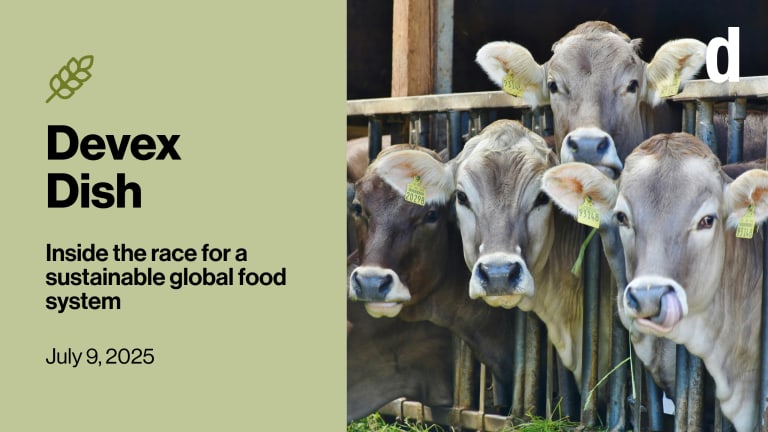
The International Monetary Fund has downgraded its forecast for global growth in 2022, citing the COVID-19 pandemic and slowdowns in China and the United States, and warned of a persistent divergence between advanced economies and lower-income nations.
Global growth is expected to drop from 5.9% in 2021 to 4.4% this year, half a percentage point lower than the fund’s October forecasts for 2022. For 2023, the expectation is 3.8% growth.
China’s tough COVID-19 restrictions and financial distress in its real estate sector, as well as the stalled Build Back Better legislation in Washington, were among the factors dragging down the estimate.
Sign up for Devex Invested
The must-read weekly newsletter that keeps you up to date with news about business, finance, and the SDGs.
Among the multiple challenges this year will be inflation and debt stocks, the fund said in its World Economic Outlook update released Tuesday and succinctly titled “Rising Caseloads, a Disrupted Recovery, and Higher Inflation.” The inflation prospect is looking tougher for the developing world, whose average prices are likely to climb by 5.9%, compared with an expected 3.9% in advanced economies.
Among the issues driving inflation in lower-income countries, such as those in sub-Saharan Africa, are elevated food prices, which are expected to rise another 4.5% this year before subsiding in 2023, according to IMF.
Adding to the unpredictability of the road ahead, a potential war in Europe over Ukraine could cause further inflation due to rising energy prices, Gita Gopinath, the first deputy managing director at IMF, told reporters Tuesday.
The global inflation issue is likely to drive a tighter monetary policy, including interest rate hikes by the U.S. Federal Reserve, and this will have serious implications for countries with high debt levels, especially ones reliant on external financing, according to the report. More aggressive rate hikes would hit even harder.
“We have about 60% of low-income countries that we describe as being already in debt distress or at risk of debt distress,” Gopinath said.
She urged the G-20 group of nations to “deliver quickly” on a debt relief mechanism for countries facing huge debt burdens and to suspend debt service payments while a deal is negotiated. Her remarks echo growing consternation at the World Bank over unsustainable debt levels for many low-income nations and the potential for “disorderly defaults.”
In the report, IMF said “high post-pandemic debt burdens will be an ongoing challenge for years to come” in emerging market and developing economies.
China is owed 37% of poor countries' debt payments in 2022: World Bank
Debt in the developing world is no longer mostly owed to the club of wealthy Western donors.
The latest update to the global economic forecast was also downbeat on the prospect of hitting the World Health Organization’s target of vaccinating 70% of populations in every country by midyear.
“Some emerging market and developing economies are anticipated to fall short of the vaccination target in 2022 and achieve sufficiently broad coverage only in 2023,” the report said.
Gopinath said insufficient vaccine deliveries and a lack of clarity on dose donations hamstrung the 2021 objectives. This year, the problem may relate more to countries’ ability to turn supply into administered vaccinations.
“A very critical area is to ensure low-income countries have the support to give shots in arm,” Gopinath said, adding that this includes addressing gaps in health infrastructure and issues around vaccine hesitancy.
In the report, IMF also called for better deliveries of therapeutics and increasing the availability of testing around the world, in addition to more vaccinations.
The fund has been pushing for $50 billion in global investments to end the pandemic globally, including through funding for vaccine production and distribution, as well as testing capacity. But Gopinath said the proposal is still seeing shortages on the financing side, including some $16 billion in grants for lower-income countries.
Moreover, even the revised economic outlook faces risks, according to the IMF report, with the path of the pandemic among the key drivers of uncertainty. Other concerns relate to interest rate hikes and supply chain disruptions.
“Many of the challenges that the world is facing are because we still remain in the grip of the pandemic,” said Gopinath. “We have a pandemic that we are now estimating will cost the global economy $13.8 trillion by 2024.” This figure is up from a previous estimate of about $12.5 trillion.
Much of the pain is felt in countries that were in weaker economic shape going into the pandemic. Some 70 million more people are in extreme poverty now than before the health crisis.









